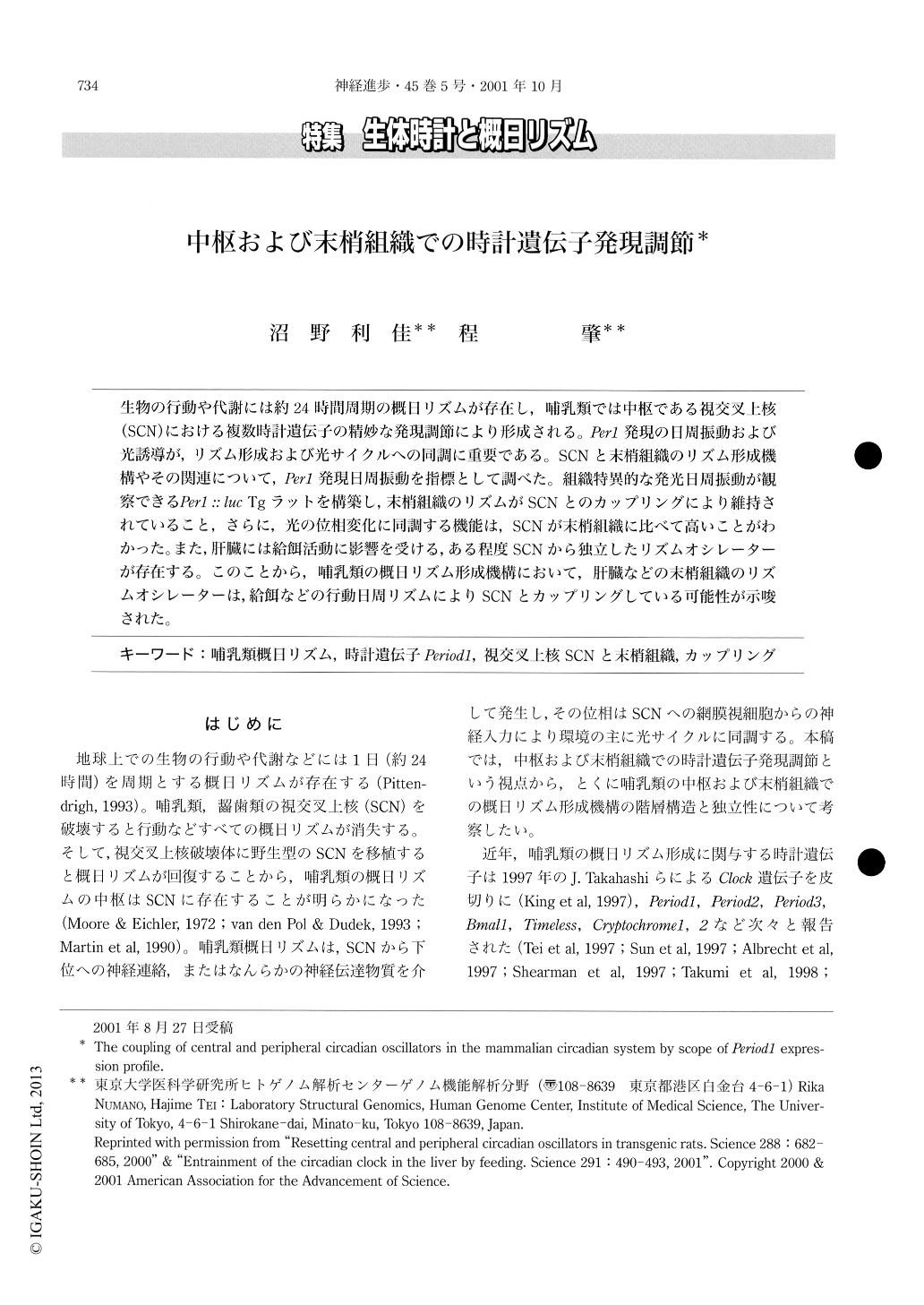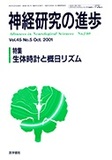Japanese
English
- 有料閲覧
- Abstract 文献概要
- 1ページ目 Look Inside
生物の行動や代謝には約24時間周期の概日リズムが存在し,哺乳類では中枢である視交叉上核(SCN)における複数時計遺伝子の精妙な発現調節により形成される。Rer1発現の日周振動および光誘導が,リズム形成および光サイクルへの同調に重要である。SCNと末梢組織のリズム形成機構やその関連について,Rer1発現日周振動を指標として調べた。組織特異的な発光日周振動が観察できるRer1::luc Tgラットを構築し,末梢組織のリズムがSCNとのカップリングにより維持されていること,さらに,光の位相変化に同調する機能は,SCNが末梢組織に比べて高いことがわかった。また,肝臓には給餌活動に影響を受ける,ある程度SCNから独立したリズムオシレーターが存在する。このことから,哺乳類の概日リズム形成機構において,肝臓などの末梢組織のリズムオシレーターは,給餌などの行動日周リズムによりSCNとカップリングしている可能性が示唆された。
The biochemical, physiological and behavioral processes are under the control of internal clocks with the period of approximately 24 hr. Circadian rhythms persist under a constant condition and can be entrained by environ-mental cues, such as light. Many physiological and behavioral studies have revealed that the central circadian pace-maker is located at the suprachiasmatic nucleus (SCN) of the hypothalamus in mammals.
Many clock gene, from Period1 (Per1) down, Per2 and Per3, clock, Bmall, Cryptochromel (Cry1) , Cry2 open the way to uncover the molecular mechanism of mammalian circadian rhythms. The exquisite balance of rhythmic ex-pression between these clock genes keeps the mammalian circadian system by some mutant animal reports with abnormal rhythms. The expression of Per1 oscillates autonomously in the SCN under light and dark (LD) and con-stant dark (DD) conditions and is induced immediately after a light pulse. These facts indicate the circadian oscil-lation and the induction of Per1 expression by light in the SCN have important roles in the mammalian circadian systems. In addition, the rhythmic expression of mPer1 is shown also in some peripheral tissues. We can consider Per1 expression as a good indicator of mammalian circadian rhythms in both SCN and peripheral tissues.
In mammals, the SCN contains autonomous circadian oscillators that act as a pacemaker at the top of the hier-archical circadian system. Some external stimulation like light conditions give firstly to the SCN and effect to pe-ripheral tissues by coupling with the SCN. In order to understand the relationship between the circadian oscilla-tior of the central and peripheral rhythms, we have constructed Per1 :: luc transgenic rats, and a realtime morning system of Per1 expression. It suggests that the daily rhythm of luciferase emission in the SCN is autonomously maintained and independent of other structures and that daily oscillations in peripheral tissues are maintained by some signals from the SCN. In addition, we compared resynchronized abilities in response to 6 hour advance phase shift and delay phase shift of the environmental light cycle among emission rhythms from the SCN, and from peripheral tissues and locomotor behavior in Tg rats. The circadian rhythm in the SCN shifted most rapidly within one day, while the circadian rhythms in peripheral tissues and locomotor rhythms took more than two days until synchronizing to a new light cycle. These data suggest that a self-sustained circadian pacemaker in the SCN entrains circadian oscillators in the periphery to maintain each adaptive phase control.
Moreover, the restricted feeding entrained the phase of Per1 expression rhythm in the liver independently of the SCN and the light cycle. It suggests that the peripheral tissues have the circadian oscillators coupled with SCN central oscillator thought specific rhythmic behavior.
I think it very effective to research the reference and independence between central and peripheral tissues in circadian clock system. It is because that we can understand the advance of efficient system by the specialization and integration of some tissues. It has been very convenient if we could control our circadian rhythms freely. The development of this field is also put social hopes not only academic.

Copyright © 2001, Igaku-Shoin Ltd. All rights reserved.


